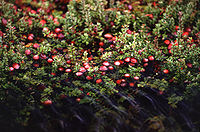
Photo from wikipedia
Vector-borne pathogens, such as phytoplasmas, are known to manipulate both host plants and insect vectors to enhance their own transmission. In cranberries, phytoplasma infection causes false blossom disease, which is… Click to show full abstract
Vector-borne pathogens, such as phytoplasmas, are known to manipulate both host plants and insect vectors to enhance their own transmission. In cranberries, phytoplasma infection causes false blossom disease, which is vectored by blunt-nosed leafhoppers (Limotettix vaccinii Van Duzee). We explored how phytoplasma infection of vegetative cranberry tissues affects the developmental performance and host preferences of L. vaccinii, and compared volatile emissions and phytohormone levels of infected and uninfected plants. In no-choice performance assays, L. vaccinii survival was similar on infected and uninfected cranberry plants. However, nymphs on infected plants took longer to reach adulthood, and produced larger adults, than those on uninfected plants. In oviposition tests, L. vaccinii females laid more eggs on uninfected than phytoplasma-infected cranberry plants. Olfactometer studies revealed preferences of L. vaccinii nymphs and adults for odors of uninfected plants when compared to clean air but not when compared to infected plants. Uninfected plants emitted higher amounts of volatiles than infected plants, particularly (E)-4,8-dimethyl-1, 3, 7-nonatriene, dodecane, and germacrene-D; however, we observed no effect of infection on phytohormone levels. Overall, our data show an oviposition preference of L. vaccinii for healthy plants, whereas our attraction data show no preference between infected and uninfected plants. While slower development on phytoplasma-infected cranberry plants led to larger adult size, there was no evidence for any beneficial effects of infection on other L. vaccinii performance parameters. Results from these studies are of relevance to understand tripartite plant-phytoplasma-insect vector interactions and are discussed in the context of the vector manipulation hypothesis.
Journal Title: Journal of Chemical Ecology
Year Published: 2019
Link to full text (if available)
Share on Social Media: Sign Up to like & get
recommendations!